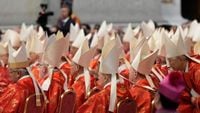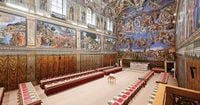The Catholic Church is on the brink of a significant transition as it prepares for a historic conclave on May 7, 2025, in the Sistine Chapel, where 135 cardinals from around the globe will convene to elect a new Pope following the death of Pope Francis on April 21, 2025. This process, steeped in tradition and secrecy, marks a pivotal moment for the Church and its 1.4 billion followers worldwide.
The College of Cardinals, which comprises 252 members, will see only 135 eligible to vote due to the stipulations of the Apostolic Constitution Universi Dominici Gregis, which restricts voting rights to cardinals under the age of 80. This conclave will be notable for its diversity, as the 135 cardinals hail from 71 countries, including representatives from 12 nations that have never been part of this process before, such as Haiti, Cape Verde, Papua New Guinea, Luxembourg, Sweden, and South Sudan.
Among the cardinals participating in the conclave are two from Mexico: Carlos Aguiar Retes, the archbishop primate of Mexico, and Francisco Robles Ortega, the archbishop of Guadalajara. Both men are positioned as potential successors to the papacy, with Aguiar Retes being 75 years old and Robles Ortega at 76.
Aguiar Retes, born on January 9, 1950, in Tepic, Nayarit, has been a significant figure in the Church, having been appointed cardinal by Pope Francis in 2016 and becoming archbishop primate a year later. He is known for his progressive views, supporting inclusivity within the Church, although he has also opposed the legalization of abortion, calling it a "false solution."
Robles Ortega, born on March 2, 1949, in Mascota, Jalisco, has had a long and distinguished career within the Church, having been ordained in 1976 and elevated to cardinal by Pope Benedict XVI in 2007. This conclave marks his second participation in the election process, having previously been involved in the selection of Jorge Mario Bergoglio in 2013.
This conclave is set against a backdrop of significant challenges facing the Catholic Church, including internal divisions between traditionalists and reformists. The legacy of Pope Francis, which emphasizes social justice, inclusivity, and environmental stewardship, will undoubtedly influence the cardinals' decisions as they seek a leader who can navigate these complex issues.
The voting process will commence at 8:30 AM Mexico time, following a ceremonial oath taken by each cardinal, pledging to maintain the secrecy of the conclave. The results are anticipated within the first 72 hours, although there are no strict deadlines. Traditionally, the outcome is signaled by the color of smoke emitted from the Sistine Chapel—black for no decision, white for the election of a new pope.
Experts suggest that the conclave's outcome could redefine the Church's direction for years to come. With a growing number of Catholics in Latin America, the prospect of electing a Latin American pope for the second consecutive time is generating considerable interest. Analysts have pointed out that the presence of Aguiar Retes and Robles Ortega could signify a shift toward a more globally inclusive Church, particularly as they represent one of the largest Catholic communities in the world.
This year's conclave will also see a reduced Mexican presence compared to past elections. In previous conclaves, such as those for Popes John Paul II, Benedict XVI, and Francis, Mexico had three voting cardinals, whereas this year only Aguiar Retes and Robles Ortega will cast their votes. This decline in representation has raised concerns among observers about the future influence of Mexican cardinals within the Church.
Elio Masferrer, an anthropologist specializing in religion, noted that the reduced number of Mexican cardinals eligible to vote reflects the broader trend of Pope Francis' appointments, which have favored individuals who align with his vision of a more inclusive Church. He stated, “The election of the new Pope will occur between traditionalists and those who follow Francis.”
As the conclave unfolds, the eyes of the world will be on the Sistine Chapel, where the cardinals will deliberate and vote in secrecy. The implications of their choice extend far beyond the Vatican, impacting the lives of millions of Catholics and the Church's role in global issues such as migration, civil rights, and social justice.
In the lead-up to the conclave, both Aguiar Retes and Robles Ortega have expressed their hopes for a leader who can embody the Church's commitment to compassion and social responsibility. With the Catholic Church facing unprecedented challenges, the next pope will need to navigate a complex landscape of faith, culture, and modernity.
The conclave of 2025 not only represents a moment of transition for the Catholic Church but also serves as a reflection of its evolving identity in the 21st century. As the world watches, the decisions made within the walls of the Sistine Chapel will shape the future of the Church and its mission to serve humanity.


